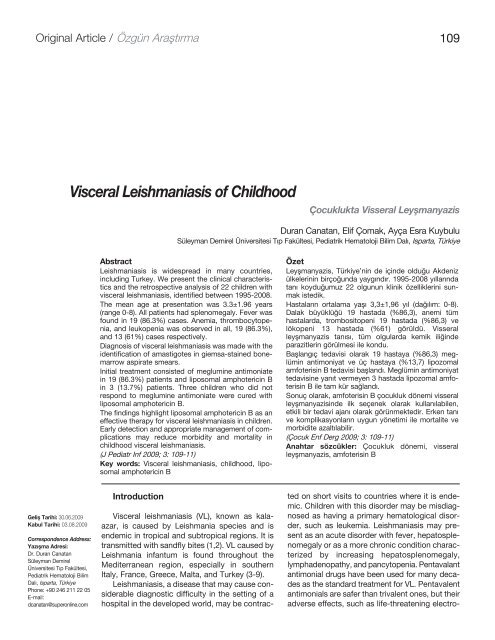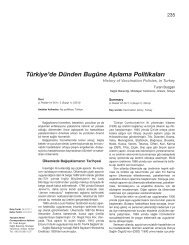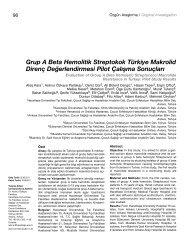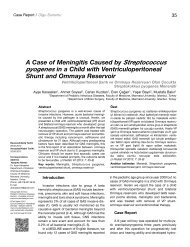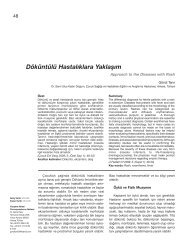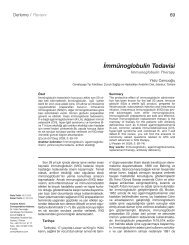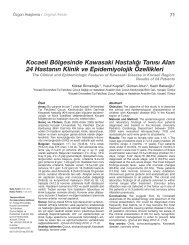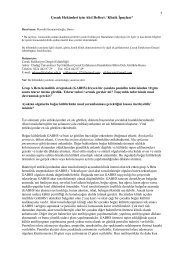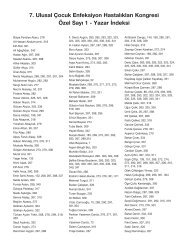Visceral Leishmaniasis of Childhood
Visceral Leishmaniasis of Childhood
Visceral Leishmaniasis of Childhood
You also want an ePaper? Increase the reach of your titles
YUMPU automatically turns print PDFs into web optimized ePapers that Google loves.
Original Article / Özgün Araştırma 109<br />
Geliş Tarihi: 30.06.2009<br />
Kabul Tarihi: 03.08.2009<br />
Correspondence Address:<br />
Yazışma Adresi:<br />
Dr. Duran Canatan<br />
Süleyman Demirel<br />
Üniversitesi Tıp Fakültesi,<br />
Pediatrik Hematoloji Bilim<br />
Dalı, Isparta, Türkiye<br />
Phone: +90 246 211 22 05<br />
E-mail:<br />
11 dcanatan@superonline.com<br />
<strong>Visceral</strong> <strong>Leishmaniasis</strong> <strong>of</strong> <strong>Childhood</strong><br />
Abstract<br />
<strong>Leishmaniasis</strong> is widespread in many countries,<br />
including Turkey. We present the clinical characteristics<br />
and the retrospective analysis <strong>of</strong> 22 children with<br />
visceral leishmaniasis, identified between 1995-2008.<br />
The mean age at presentation was 3.3±1.96 years<br />
(range 0-8). All patients had splenomegaly. Fever was<br />
found in 19 (86.3%) cases. Anemia, thrombocytopenia,<br />
and leukopenia was observed in all, 19 (86.3%),<br />
and 13 (61%) cases respectively.<br />
Diagnosis <strong>of</strong> visceral leishmaniasis was made with the<br />
identification <strong>of</strong> amastigotes in giemsa-stained bonemarrow<br />
aspirate smears.<br />
Initial treatment consisted <strong>of</strong> meglumine antimoniate<br />
in 19 (86.3%) patients and liposomal amphotericin B<br />
in 3 (13.7%) patients. Three children who did not<br />
respond to meglumine antimoniate were cured with<br />
liposomal amphotericin B.<br />
The findings highlight liposomal amphotericin B as an<br />
effective therapy for visceral leishmaniasis in children.<br />
Early detection and appropriate management <strong>of</strong> complications<br />
may reduce morbidity and mortality in<br />
childhood visceral leishmaniasis.<br />
(J Pediatr Inf 2009; 3: 109-11)<br />
Key words: <strong>Visceral</strong> leishmaniasis, childhood, liposomal<br />
amphotericin B<br />
Introduction<br />
<strong>Visceral</strong> leishmaniasis (VL), known as kalaazar,<br />
is caused by Leishmania species and is<br />
endemic in tropical and subtropical regions. It is<br />
transmitted with sandfly bites (1,2). VL caused by<br />
Leishmania infantum is found throughout the<br />
Mediterranean region, especially in southern<br />
Italy, France, Greece, Malta, and Turkey (3-9).<br />
<strong>Leishmaniasis</strong>, a disease that may cause considerable<br />
diagnostic difficulty in the setting <strong>of</strong> a<br />
hospital in the developed world, may be contrac-<br />
Çocuklukta Visseral Leyşmanyazis<br />
Duran Canatan, Elif Çomak, Ayça Esra Kuybulu<br />
Süleyman Demirel Üniversitesi Tıp Fakültesi, Pediatrik Hematoloji Bilim Dalı, Isparta, Türkiye<br />
Özet<br />
Leyşmanyazis, Türkiye’nin de içinde olduğu Akdeniz<br />
ülkelerinin birçoğunda yaygındır. 1995-2008 yıllarında<br />
tanı koyduğumuz 22 olgunun klinik özelliklerini sunmak<br />
istedik.<br />
Hastaların ortalama yaşı 3,3±1,96 yıl (dağılım: 0-8).<br />
Dalak büyüklüğü 19 hastada (%86,3), anemi tüm<br />
hastalarda, trombositopeni 19 hastada (%86,3) ve<br />
lökopeni 13 hastada (%61) görüldü. Visseral<br />
leyşmanyazis tanısı, tüm olgularda kemik iliğinde<br />
parazitlerin görülmesi ile kondu.<br />
Başlangıç tedavisi olarak 19 hastaya (%86,3) meglümin<br />
antimoniyat ve üç hastaya (%13,7) lipozomal<br />
amfoterisin B tedavisi başlandı. Meglümin antimoniyat<br />
tedavisine yanıt vermeyen 3 hastada lipozomal amfoterisin<br />
B ile tam kür sağlandı.<br />
Sonuç olarak, amfoterisin B çocukluk dönemi visseral<br />
leyşmanyazisinde ilk seçenek olarak kullanılabilen,<br />
etkili bir tedavi ajanı olarak görünmektedir. Erken tanı<br />
ve komplikasyonların uygun yönetimi ile mortalite ve<br />
morbidite azaltılabilir.<br />
(Ço cuk En f Der g 2009; 3: 109-11)<br />
Anahtar sözcükler: Çocukluk dönemi, visseral<br />
leyşmanyazis, amfoterisin B<br />
ted on short visits to countries where it is endemic.<br />
Children with this disorder may be misdiagnosed<br />
as having a primary hematological disorder,<br />
such as leukemia. <strong>Leishmaniasis</strong> may present<br />
as an acute disorder with fever, hepatosplenomegaly<br />
or as a more chronic condition characterized<br />
by increasing hepatosplenomegaly,<br />
lymphadenopathy, and pancytopenia. Pentavalant<br />
antimonial drugs have been used for many decades<br />
as the standard treatment for VL. Pentavalent<br />
antimonials are safer than trivalent ones, but their<br />
adverse effects, such as life-threatening electro-
110<br />
Canatan et al.<br />
<strong>Visceral</strong> <strong>Leishmaniasis</strong> <strong>of</strong> <strong>Childhood</strong><br />
cardiographic changes are frequent (10). During the last<br />
decade, the emergence <strong>of</strong> Leishmania strains that are<br />
resistant to pentavalent antimonials and the occurrence <strong>of</strong><br />
side-effects have prompted the evaluation <strong>of</strong> other drugs,<br />
including lipid formulations <strong>of</strong> amphotericin B (8,9,11,12).<br />
Liposomal amphotericine B (L-AmB) was the first drug<br />
approved for the treatment <strong>of</strong> visceral leishmaniasis by the<br />
United States Food and Drug Administration (13). The purpose<br />
<strong>of</strong> this study was to investigate the epidemiological,<br />
clinical, laboratory and therapeutic features <strong>of</strong> 22 children<br />
affected by VL in southern Turkey retrospectively.<br />
Material and Methods<br />
All children diagnosed as VL during the years 1995-<br />
2008 were included in study. All the data were taken from<br />
patient records. Demographic characteristics, clinical and<br />
laboratory findings, therapeutic interventions and clinical<br />
outcomes were noted. Diagnosis <strong>of</strong> VL was established<br />
with giemsa-stained bone marrow aspirate smears in all<br />
cases.<br />
The patients who presented from 1995 up to 2000<br />
were treated with meglumine antimoniate (MA) (Glucantim;<br />
Rhone-Poulenc, France) whereas those who presented<br />
thereafter were treated with L-AmB (AmBisome; Gilead,<br />
USA). MA was administered intramuscularly for 21 days at<br />
a dosage <strong>of</strong> 20 mg/kg/day. L-AmB was administered intravenously<br />
at a dosage <strong>of</strong> 3 mg/kg for 10 days. All patients<br />
were hospitalized during treatment. L-AmB was used for<br />
three patients for the initial treatment and for three patients<br />
that did not respond to antimonial treatment<br />
(4,5,8,9,11).<br />
Clinical response was assessed at the completion <strong>of</strong><br />
treatment. Most <strong>of</strong> the patients were followed up for at<br />
least six months after completion <strong>of</strong> treatment.<br />
Results<br />
Twenty two children were diagnosed with VL. The<br />
median age <strong>of</strong> the patients was 3.3±1.9 years (range: 1-8<br />
years). No patient had an underlying disease on admission.<br />
Splenomegaly, hepatomegaly, and fever were found in<br />
all (100%), 20 (91%), and 19 (86.3%) patients on initial<br />
physical examination (Table 1). All patients had anemia.<br />
Tab le 1. Clinical features <strong>of</strong> children at admission<br />
Clinical features no. <strong>of</strong> cases %<br />
Fever 19 86.3<br />
Abdominal distention 14 63.6<br />
Pallor 14 63.6<br />
Fatigue 5 22.7<br />
Lack <strong>of</strong> appetite 4 18<br />
Splenomegaly 22 100<br />
Hepatomegaly 20 91<br />
Thrombocytopenia (
Ço cuk En f Der g 2009; 3: 109-11<br />
J Pediatr Inf 2009; 3: 109-11<br />
Tab le 2. Hematological and biochemical features <strong>of</strong> children at admission<br />
When compared with other drugs used in the treatment<br />
<strong>of</strong> VL, treatment with pentavalent antimonial compounds<br />
is cheaper as the agent is readily supplied free <strong>of</strong> charge<br />
by the Ministry <strong>of</strong> Health in Turkey and the clinical response<br />
is also much better; hence it is still the antimicrobial <strong>of</strong><br />
choice for VL. The resistance to this class <strong>of</strong> drugs is usually<br />
seen in India and Africa (1). In our series, the resistance<br />
was noted in 21% <strong>of</strong> patients.<br />
Amphotericin B has good antiprotozoan activity, buthas<br />
limitations because <strong>of</strong> its dosage dependent sideeffects,<br />
including nephrotoxicity and thrombophlebitis.<br />
L-AmB is especially suitable for the treatment <strong>of</strong> leishmaniasis,<br />
because the drug is concentrated in the reticuloendothelial<br />
system; however, the cost precludes its wider<br />
use in developing countries (8,11,12). All our patients who<br />
used L-AmB were cured. After six months <strong>of</strong> follow up, no<br />
relapses were seen.<br />
In conclusion, L-AmB appears to be an effective therapy<br />
for VL in children and could be used as a first line treatment.<br />
Early detection and appropriate management <strong>of</strong><br />
complications may reduce morbidity and mortality in<br />
childhood VL.<br />
References<br />
1. Guerin PJ, Olliaro P, Sundar S, et al. <strong>Visceral</strong> leishmaniasis: current<br />
status <strong>of</strong> control, diagnosis, and treatment, and a proposed<br />
research and development agenda. Lancet Infect Dis 2002; 2:<br />
494-501.<br />
2. Peter CM. Leishmania. In: Behrman RE, Kliegman RM, Jenson<br />
HB (eds). Nelson Textbook <strong>of</strong> Pediatrics. 16th ed. Philadelphia:<br />
W B Saunders 2000. p. 1041-4.<br />
3. Ozbel Y, Turgay N, Ozensoy S, et al. Epidemiology, diagnosis<br />
and control <strong>of</strong> leishmaniasis in the Mediterranean region. Ann<br />
Trop Med Parasitol 1995; 89 Suppl 1: 89-93.<br />
Canatan et al.<br />
<strong>Visceral</strong> <strong>Leishmaniasis</strong> <strong>of</strong> <strong>Childhood</strong><br />
Variable Median value (SD) Range<br />
Hemoglobin (g/dL) 6.7±2.03 3.4-9<br />
Hematocrit (%) 20.1±7.75 9.5-25.7<br />
Leukocyte count (X109 cells/L) 4.0±2.18 1.2-10.4<br />
Platelets (X109 cells/L) 83.52±61.23 2-218<br />
Erythrocyte sedimentation rate (mm/h) 68.5±40.5 20-140<br />
Fibrinogen (mg/dL) 281.15±93.23 110-473<br />
Albumin (gr/dL) 3.06±3.2 1.8-4.5<br />
Total protein (g/dL) 7.53±6.5 4.6-10.7<br />
Table 3. Treatment and outcome <strong>of</strong> 22 children with visceral leishmaniasis<br />
Drug Dosage Duration <strong>of</strong> therapy No. <strong>of</strong> cases Clinical response Treatment failure<br />
Meglumine antimoniate 20 mg/kg/day 20 days 19 16/19 21%<br />
Liposomal AmB 3 mg/kg/day 10 days 3<br />
patients, initially<br />
3 more patients<br />
added thereafter<br />
6/6 0%<br />
111<br />
4. Di Martino L, Davidson RN, Giacchino R, Scotti S, Raimondi F,<br />
Castagnola E, Tasso L, Cascio A, Gradoni L, Gramiccia M,<br />
Pettoello-Mantovani M, Bryceson AD. Treatment <strong>of</strong> visceral<br />
leishmaniasis in children with liposomal amphotericin B. J<br />
Pediatr 1997; 131: 271-2.<br />
5. Minodier P, Piarroux R, Garnier JM, Unal D, Perrimond H, Dumon<br />
H. Pediatric visceral leishmaniasis in southern France. Pediatr<br />
Infect Dis J 1998; 17: 701-4.<br />
6. Maltezou HC, Siafas C, Mavrikou M, Spyridis P, Stavrinadis C,<br />
Karpathios T, Kafetzis DA. <strong>Visceral</strong> lesihmaniasis during childhood<br />
in southern Greece. Clin Infect Dis 2000; 31: 1139-43.<br />
7. Grech V, Mizzi J, Mangion M, Vella C. <strong>Visceral</strong> leishmaniasis in<br />
Malta--an 18 year paediatric, population based study. Arch Dis<br />
Child 2000; 82: 381-5.<br />
8. Syriopoulou V, Daikos GL, Theodoridou M, et al. Two doses <strong>of</strong> a<br />
lipid formulation <strong>of</strong> amphotericin B for the treatment <strong>of</strong><br />
Mediterranean visceral leishmaniasis. Clin Infect Dis 2003; 36:<br />
560-6.<br />
9. Dursun O, Erişir S, Yeşilipek A. <strong>Visceral</strong> <strong>Childhood</strong> <strong>Leishmaniasis</strong><br />
In Southern Turkey: Experience Of Twenty Years. Turk J Pediatr<br />
2009; 51: 1-5.<br />
10. Weatherall DJ. <strong>Leishmaniasis</strong>. In: Nathan DG, Oski FA (eds).<br />
Hematology <strong>of</strong> Infancy and <strong>Childhood</strong>. 4th ed. Philedelphia: W.<br />
B. Saunders Company 1993. p. 1902<br />
11. Davidson RN, Di Martino L, Gradoni L, et al. Liposomal amphotericin<br />
B (AmBisome) in Mediterranean visceral leishmaniasis: a<br />
multi-centre trial. Q J Med 1994; 87: 75-81.<br />
12. Davidson RN, di Martino L, Gradoni L, et al. Short-course treatment<br />
<strong>of</strong> visceral leishmaniasis with liposomal amphotericin B<br />
(AmBisome). Clin Infect Dis 1996; 22: 938-43.<br />
13. Meyerh<strong>of</strong>f A. U.S. Food and Drug Administration approval <strong>of</strong><br />
AmBisome (liposomal amphotericin B) for treatment <strong>of</strong> visceral<br />
leishmaniasis. Clin Infect Dis 1999; 28: 42-8.<br />
14. Akman L, Aksu HS, Wang RQ, et al. Multi-site DNA polymorphism<br />
analyses <strong>of</strong> Leishmania isolates define their genotypes predicting<br />
clinical epidemiology <strong>of</strong> leishmaniasis in a specific region.<br />
J Eukaryot Microbiol 2000; 47:545-54.


